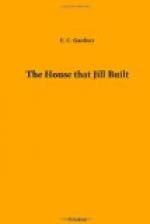“I didn’t suggest it, and I think it would be a dreadful thing—I mean to send them off on another excursion. I am not sure, however, but we might found an A.B.C.A.M. with the materials and implements in our possession.”
CHAPTER XVII.
THE RIGHT SIDE OF PAINT; A PROTEST AND A PROMISE.
Jack’s benevolent ambition to distribute their superfluous plans among those in need of such aids was strengthened by the receipt of another roll of drawings, showing designs for the interior work, wainscots, cornices, architraves, paneled ceilings and such wood finishings as are commonly found in houses that are built in conventional fashion, with lathed and plastered walls, trimmed at all corners and openings with wood more or less elaborately wrought. Of course, it was a large condescension in the architect to offer such a variety, and contrary to his avowed determination to decide without appeal all questions of construction and design, but he appreciated his clients and knew when to break his own rules and when to insist upon their observance. If Jill, had required an assortment he would doubtless have suggested that certain “practical” builders could furnish a full line of ready-made “artistic” patterns for little more than the cost of the paper on which they were printed; from these he would have advised her to select her own designs, as she might have chosen from a medicine chest sweet-smelling drops or sugar-coated pills of varying hue and form—the result would doubtless he as satisfactory in one case as in the other. Since she had not demanded it as an inalienable right he gave her an opportunity to criticise and select, which she accepted by no means unwillingly. As a rule, the designs were, in her opinion, too elaborate and obtrusive. There were too many mouldings, there was too much carving, and too evident a purpose to provide a finish that should challenge attention by its extent or elegance. It would require too much labor to keep it in order, and—it would cost too much. If she could not have work that was truly artistic, and therefore enduringly beautiful, whatever changes of fashion might occur, it was her wish to keep all the essential part of the building and finish modestly in the background, not attempting to make it ornamental, but relying upon the furniture for whatever conspicuous ornament or decoration might be desired. Nothing annoyed her more than an elegantly-finished house scantily provided with shabby, incongruous and misapplied furniture. The amiable concession of the architect came near causing a fatal quarrel, as amiable concessions are apt to do, for he found it almost impossible to satisfy Jill’s taste in the direction of simplicity; he seemed to feel that he was neglecting his duty if he gave her plain, narrow bands of wood absolutely devoid of all design beyond a designation of their width and thickness. Any carpenter’s boy could make such plans. “It would be worse,” he wrote, “than prescribing bread pills and ‘herb drink’ for a sick man.” To which Jill replied in substance that the needs of the patient are more important than professional rules.




